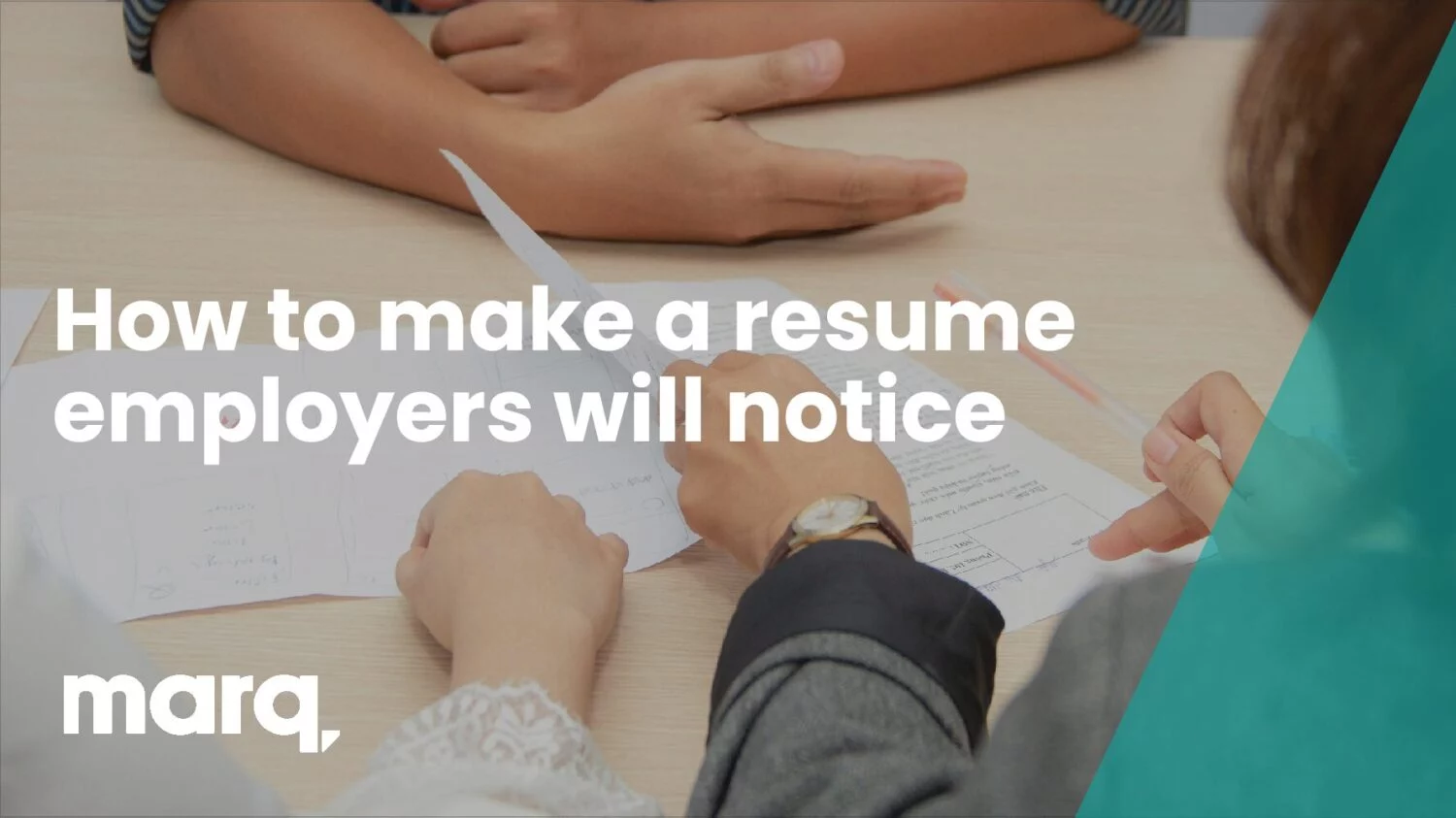Times sure have changed since you created your very first resume in a high school English class—and hopefully, you have grown professionally since then. So, let’s discuss how to make a resume.
What is a resume?
A resume provides a summary of a job seeker’s qualifications, education and work experience. It is typically a one or two-page written document that market’s a job seeker as a qualified candidate for a position.
Related: Resume examples & writing tips
First things first, start by gathering information about your past work experiences, employers, education, skills, references, volunteering, military service, awards, and any other work-related accomplishments. You may refer to past versions of your resume or your LinkedIn profile for these details. You can start formatting it all into a skeleton outline by topic.
Once you’ve gathered all of your information in one place, follow these steps to create your resume
1. Choose a resume format
A resume’s format determines the type of content you include in your resume and can help shape a recruiter’s perception of whether you qualify for a job. Typically a resume will be structured in one of the following formats.
Reverse-chronological resume
This traditional resume format lists your work experience starting from your most recent position and working backwards through your previous jobs. The chronological resume format is usually best-suited to recent college graduates or students, people without gaps in their work history, or job-seekers applying for roles within traditional industries.
Skills-based resume
A skills-based resume allows you to highlight what you know how to do even if you haven’t had extensive work experience in your desired industry. This can be effective when you are seeking a career change and have developed relevant skills while working in other fields or are a recent college graduate and have developed skills via college courses or volunteer work.
Combination resume
The combination resume format combines attributes of the chronological and skills-based resume. This resume format allows you to highlight extensive work experience while putting greater emphasis on your skill set. A resume using the combination format is best-suited to people who want a significant career change, or job-seekers who have a solid work history and a broad skill set.
See more about resume formats in our resume formats guide.
Format your resume quickly with our free resume builder.
2. Choose a resume layout
The best resume layout for you will depend largely on the industry and job role you are applying to. Traditional industries such as government, education or healthcare will prefer a traditional, basic resume layout with no added design elements.
If you work in a creative industry such as marketing and graphic design, a more modern or creative resume layout can help you stand out and illustrate your skills.
Struggling to design your resume? Use a free resume template to get you started.
3. Add content to your resume
Once you’ve landed on a format and design for your resume, it’s time to start adding content. To show you how to make a resume, we’ve chosen one of our favorite characters to serve as a step-by-step case study. We’ll go through each section with examples of what you should include… and what should remain a mystery. Whether or not you read the rest of this post in Benedict Cumberbatch’s velvety smooth voice is up to you.
Sections to include in a resume
- Contact information
- Summary statement
- Work Experience
- Education
- Skills
- Awards and volunteer information
Section 1: Contact information
Just like solving a crime, a resume is built by putting together the pieces. After selecting a template, begin with the header.

We’re going to start with the tough questions: Who are you, and how will the hiring employer contact you? Remember, when it comes to contact information, most employers only need your phone number and email address.
If your email address is embarrassing or goofy, perhaps a remnant of the early days of the internet, consider creating a first.last@domain.com-style address. This is also a great place to list a URL for your website or portfolio.
A 2015 study found that using an informal email address on a resume decreases your perceived hirablility as much as having spelling errors, so be sure to take your contact information seriously when adding it to your resume.
Don’t list your full mailing or physical address.
As nearly all organizations will require an application along with your resume, this is just another waste of space. In the modern workforce, employers are not going to snail-mail you any correspondence or offers.
If you’re applying to a position out-of-state, you may include your city and state for context.
Section 2: Work experience
The meat of your resume: previous work history, internships, military service, etc. List this information on your resume chronologically, starting with the most recent. Must-haves for each entry are the job title and company name. Other things to consider are dates of employment, location, supervisor name, and a short summary of your responsibilities & achievements.
If you have an extensive work history, condense it to a recent time frame or cherry-pick the most relevant work experiences to include in the resume. You can then include the URL for your LinkedIn profile or state that a full summary can be provided if needed.
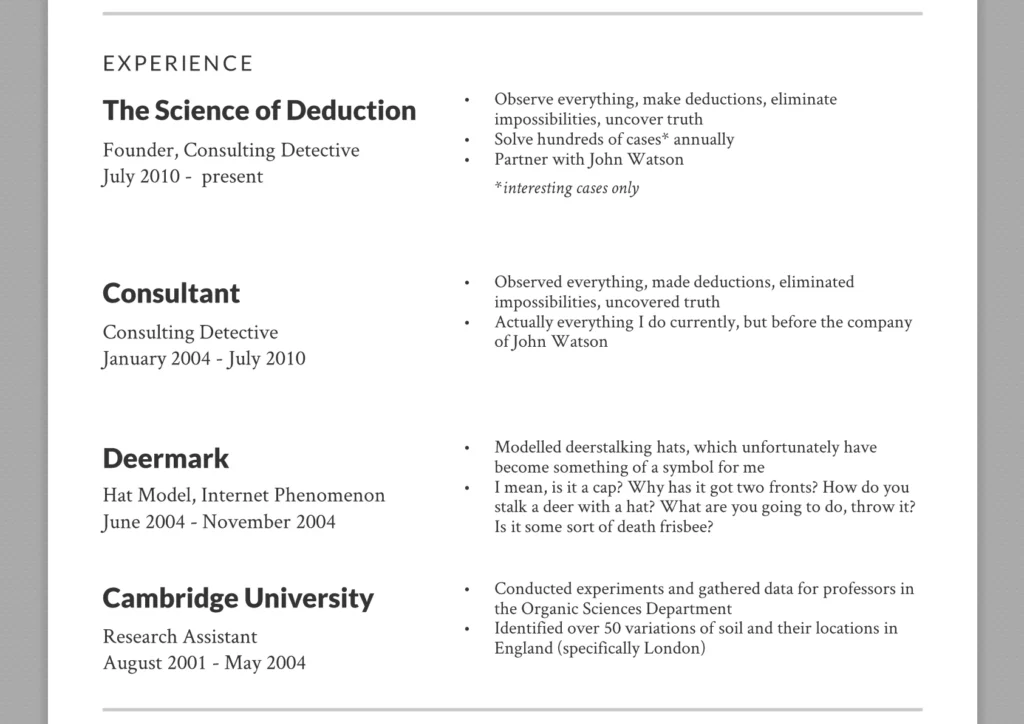
Remember to pay attention to the details. It looks like Sherlock skimped out on some of the specifics, assuming potential employers are already aware of his accomplishments. Don’t make the same mistake, because, unlike Sherlock, your reputation will probably not precede you.
How to write about your work experience
Rather than listing your job description, use action verbs to describe your accomplishments within your role in succinct bullet points. One study on hirability found applicants should include any leadership roles they’ve held and identify work they did that led to the company making more money.
When possible, provide numbers to back up your claims and give tangible examples of what you accomplished for the company. If you have examples of published projects online, add links within your resume so hiring managers can learn more.
Avoid cliches such as “rock star” or “guru” and instead use action words that connote important soft skills such as leadership or problem solving skills. Verbs recommended by career coaches and professional resume writers include:
- Redesigned
- Launched
- Solved
- Modernized
- Orchestrate
Section 3: Education & training
This section is best organized in order of precedence. First, list any degrees or diplomas, followed by certifications, then specialized training.
The must-haves for each entry are the degree or course title, school or organization, and completion date. If you are currently enrolled in a program, list it as in progress. Optional information: honors, awards, extracurricular activities, GPA, and a short summary of the program.
Don’t get stuck in the mindset that this section is only for universities. Include related training workshops, certifications, special licenses, and any other educational program.
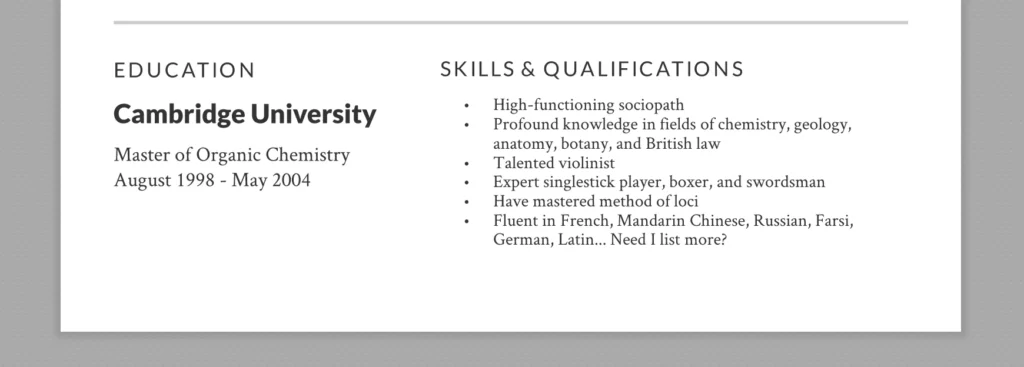
Section 4: Awards (optional)
Much like the section for education & training, list awards in order of precedence. Include the award title, the giver, and the date of presentation.
Section 5: Volunteer service & professional organizations (optional)
Employers value passion and initiative, and volunteering your time for a cause or organization is a great way to showcase these traits. List these either alphabetically or reverse-chronologically, whichever is the most fitting for the information. Include the organization and service dates. You can optionally add your title, location, cause, and a brief summary.
Including volunteer information on a resume can be particularly beneficial for those without a high school diploma or those who live in rural areas with less access to job opportunities or education.
Section 6: Skills
This section of the resume is your chance to flex. Either list traits and skills alphabetically or in order of importance to your field. This could include language fluency, software & hardware proficiency, hard & soft skills, leadership experience, and others. In general, a list of bullet is most effective in communicating hard skills. Job seekers should use specific examples within the work experience section of the resume to highlight soft soft skills.
Hard vs. soft skills
What do we mean by a “hard” skill and a “soft” skill? A hard skill is any technical skill that must be learned for a specific job. Some examples of hard skills include knowledge of specific computer softwares, knowledge of laws or process or knowledge of how to operate a specific type of equipment. Soft skills are universal to any position and are typically related to your people skills. Commonly sought after soft skills include communication, leadership, teamwork and a good work ethic. It’s most effective to display your soft skills by providing examples of when you’ve demonstrated leadership ability or good communication.
Section 7: References
List 3-5 contacts who are willing to attest to your character and work ethic. The majority, if not all, should be professional contacts, such as a coworker or supervisor. Include their name, phone number and/or email address. You may additionally include how long you’ve known this person, as well as their current title and organization.
Don’t use more than one personal reference in a resume.
Your friends & family will say nothing but nice things about you, which makes it tempting to list them as your references—but listing a coworker or supervisor will generate a more trustworthy account of who you are professionally. For this reason, strive for all professional references (or at least two of three).
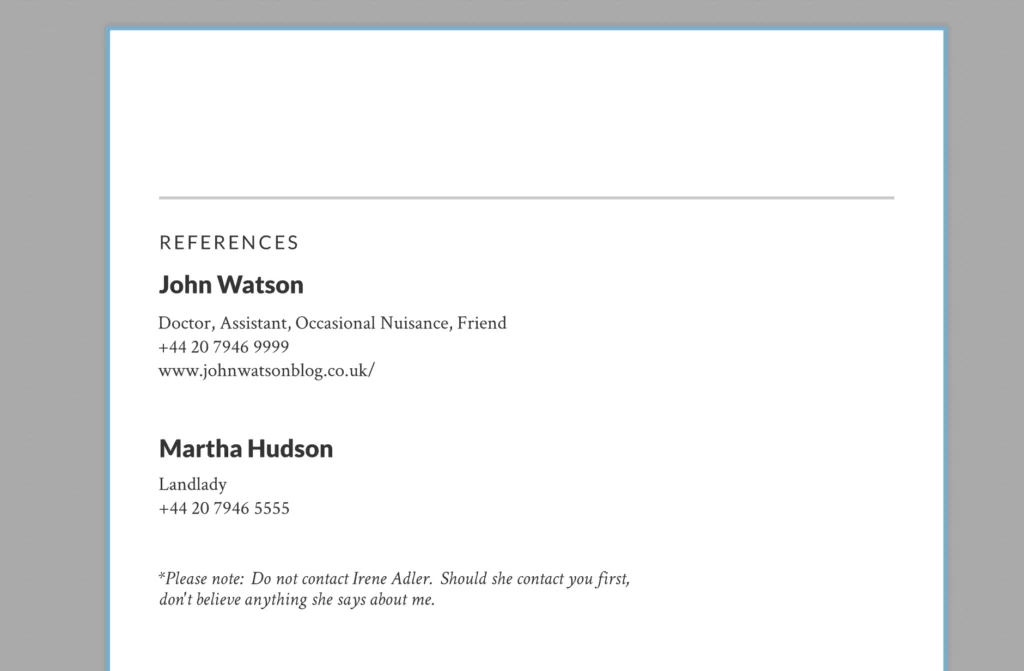
Be sure to notify your references that you are submitting their information with your resume. Not only is this polite, but it also ensures that they will be prepared to endorse you and your skills. On that note, never include references that might not speak highly of you, as well as unreliable or unpredictable sources.
Section 8: Summary statement (optional)
The old-fashioned objective statement has been replaced by a summary statement at the head of the resume. This should be a brief description of your professional experience and the skills you would bring to the table for your new employer. If you are struggling to make room on your resume, a summary statement can be removed.
Don’t include an objective in a resume.
Since real estate on your resume is so limited, this section is best left off completely—especially when you realize that all prospects have the same objective: to be hired for the job they’re applying for.
Of course, there are always exceptions to the rule—for example, you might use that space to explain an extended period of unemployment, like full-time parenting. But, don’t turn it into your biography. Instead, use a cover letter to narrate your background and personality.
4. Proofread your resume
Now that you have each section written and pared-down, it’s time to proofread and add the final touches. All resumes should follow a few basic guidelines.
Don’t write more than two pages.
A resume serves as a brief introduction to you. Brief. This means if you have an extensive work history, condense it to related work history or recent work history. If needed, you can add something like “full work history available upon request” or “full work history available on LinkedIn.” That way, hiring managers who want more context can easily find it.
Resumes are a summary of your experience, not your autobiography. You’re making a targeted case for why you are the right candidate with the right background. Narrate specific experiences in a cover letter or save them for the interview.
One study by a resume writing service found that two-page resumes are 2.3 times more likely to be chosen by recruiters or hiring managers, and hiring managers spend twice as long reviewing two-page resumes as they do one-page resumes. Having an additional page had the biggest impact on managerial-level job openings while making a smaller difference for entry-level positions. Ultimately use your best judgment on whether a second page will be beneficial.
Use font size 10 to 12 and a legible, professional typeface.
Unless you have a particular penchant for irony, please don’t use Zapfino or Comic Sans. Also, don’t assume that using font size 8 is a passable workaround for our first tip. Respecting the employer’s patience by submitting a clean, well-formatted, easy-to-read resume will take you a long way.
Check for spelling and grammar errors
As mentioned above, studies have found spelling errors in a resume can dramatically decrease the likelihood of being hired by a company. Carefully review each section and correct any typos or misplaced commas. To be extra sure, have a friend review the final draft for you.
Don’t be afraid to use color.
The majority of resumes now are viewed online, so adding a splash of color is a great way to show an eye for design and to stand out from the others. Keep it visually appealing by sticking with 2-4 complementary colors.
If you’re brave enough to use a loud color, like your favorite shade of hot pink, tone it down by pairing it with muted colors. Generally speaking, sticking to muted or cool colors (like blue and green) is the best practice and typically the most visually pleasing.
Remember, the goal is for employers to notice your resume because of its professionalism and beauty—not because it’s a total shock to the system.
Customize a pre-made resume template.
Not all of us are graphic designers, which is why using a resume builder or premade resume template is a lifesaver. Another benefit of using a resume template is knowing all your bases are covered, concise and clear.
For example, check out these 3 examples of professional resume templates by Lucidpress.
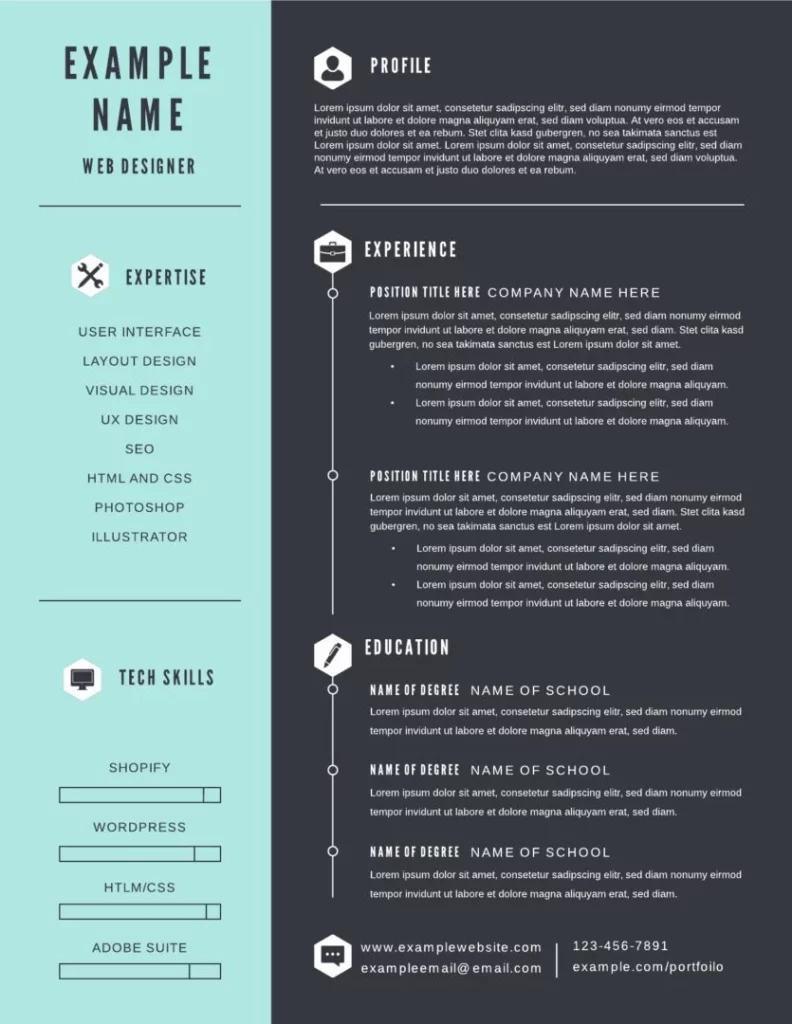
Timeline & infographic resume template
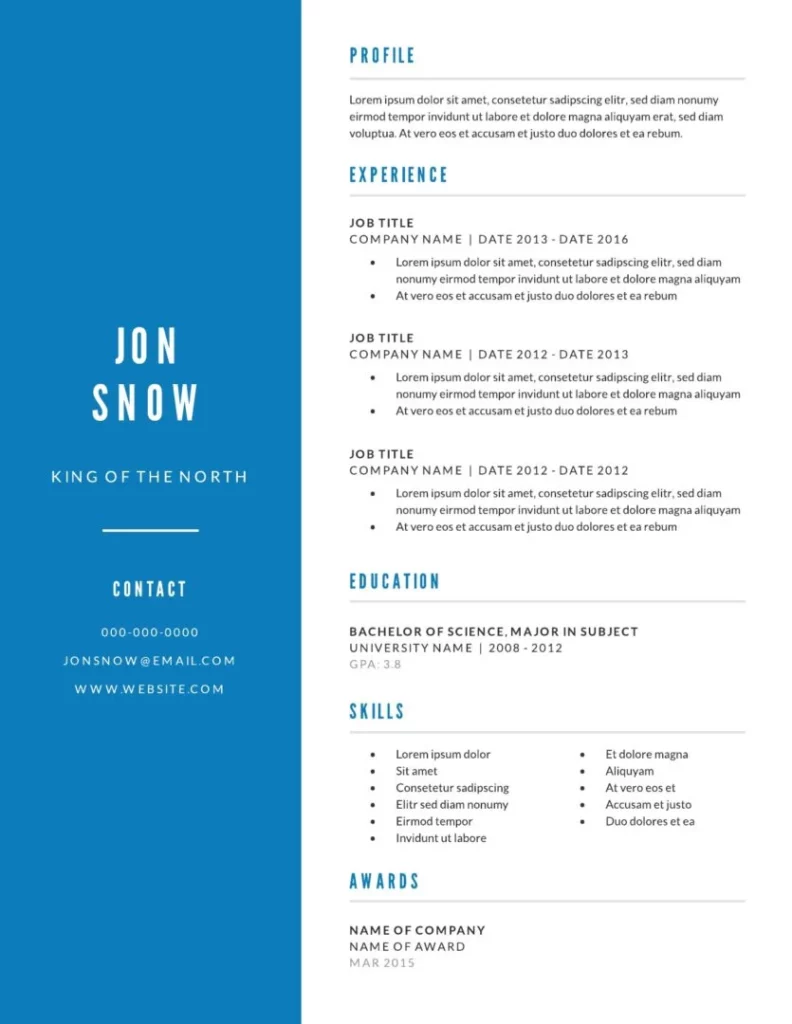
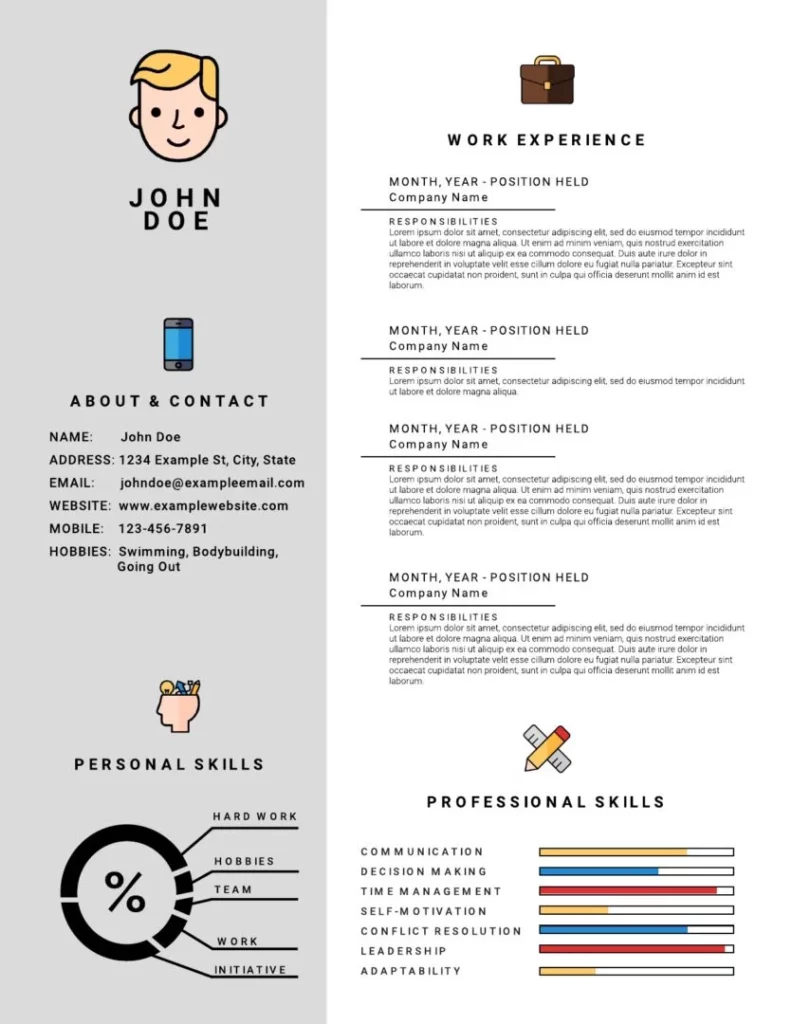
Icon infographic resume template
To see more free resume templates online, check out our template gallery.
5. Add your cover letter
Not every job listing will require a cover letter, but a well-thought-out cover letter can help bring personality to the raw facts laid out in a resume. Remember a cover letter should add to a resume not repeat it. Think of a cover letter as extra space to describe projects you worked on or what you would accomplish in the new job role.
Bonus: Good resume vs. bad resume
After following these steps and tips, you should have one well-formatted, beautiful resume that employers will notice.
If you need one last dose of inspiration, take a look at these two resume examples for a fictional candidate named Joanna Smith. It’s a good resume vs. bad resume showdown. Can you spot what she’s done well and what could be improved?
Bad resume example
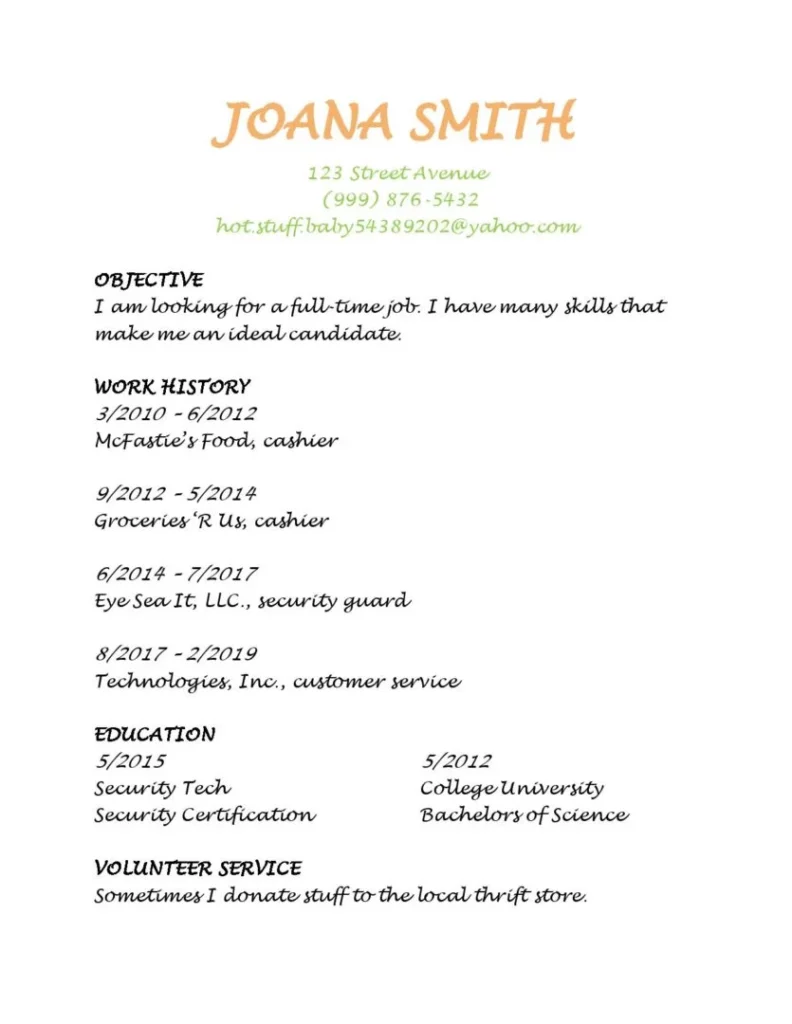

Good resume example
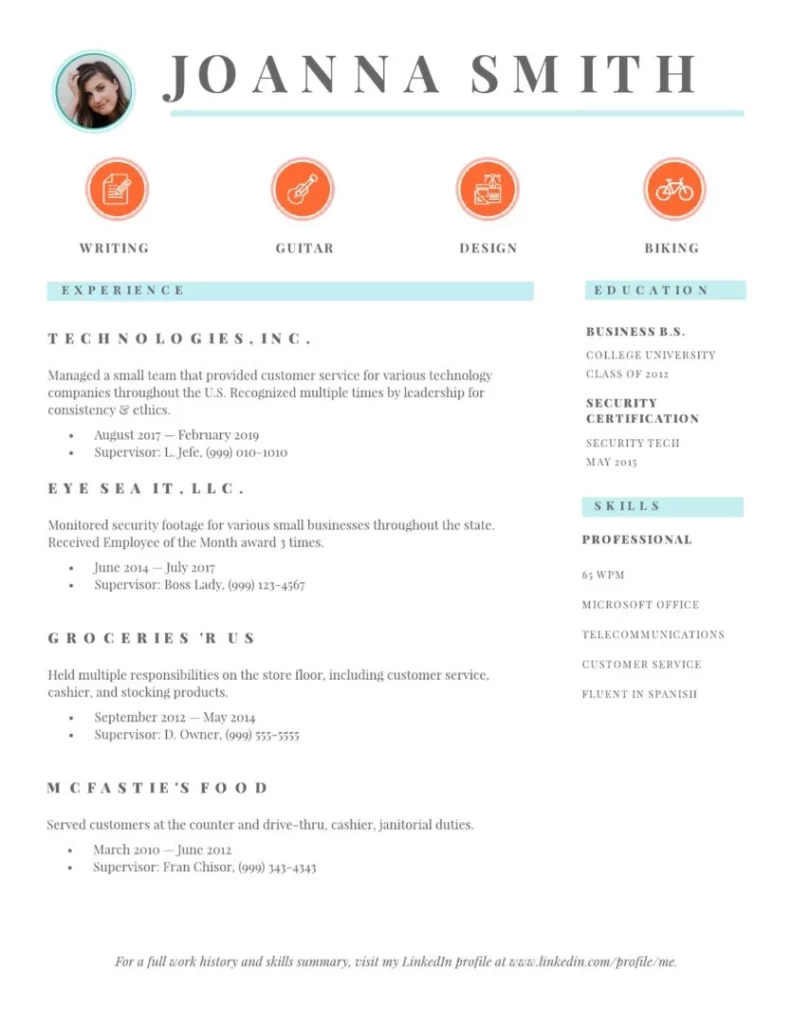
Simple as that! You’ve solved the mystery. Now that you have your resume, you are ready to crack your next case. Or, rock your job interview. Whichever you prefer. The game is on!
